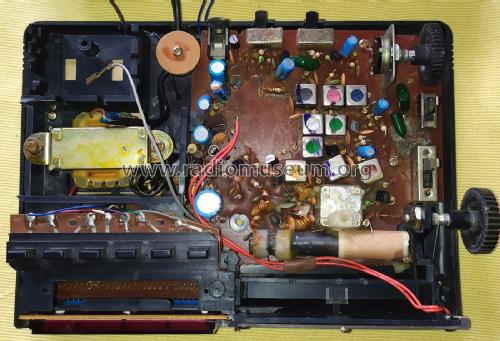Clock Radio
Oskar; Hong Kong
- Paese
- Hong Kong
- Produttore / Marca
- Oskar; Hong Kong
- Anno
- 1980 ?
- Categoria
- Radio (o sintonizzatore del dopoguerra WW2)
- Radiomuseum.org ID
- 330337
- Numero di transistor
- 12
- Principio generale
- Supereterodina (in generale)
- Gamme d'onda
- Onde medie (OM) e MF (FM).
- Tensioni di funzionamento
- Alimentazione a corrente alternata (CA) / 220 Volt
- Altavoz
- AP magnetodinamico (magnete permanente e bobina mobile) / Ø 7.5 cm = 3 inch
- Material
- Plastica (non bachelite o catalina)
- Radiomuseum.org
- Modello: Clock Radio - Oskar; Hong Kong
- Forma
- Soprammobile con orologio (radio-orologio, radiosveglia).
- Dimensioni (LxAxP)
- 220 x 50 x 160 mm / 8.7 x 2 x 6.3 inch
- Annotazioni
-
The Oskar Clock Radio runs from 220 VAC 50 Hz mains (as used in continental Europe at the time) and uses a 9 V dry battery (Eveready 216 or Burgess 2U6) as a power backup to keep the clock time during AC power outages.
At least two versions of this model were made, differing only in color of the LED display and the dial scale: red or green.
Frequency ranges:
- FM = 87.5 - 108 MHz
- AM = 520 - 1605 kHz
The main PCB of this model is marked with "OSCAR".
- Peso netto
- 0.5 kg / 1 lb 1.6 oz (1.101 lb)
- Autore
- Modello inviato da Jose Mesquita. Utilizzare "Proponi modifica" per inviare ulteriori dati.
- Altri modelli
-
In questo link sono elencati 10 modelli, di cui 7 con immagini e 1 con schemi.
Elenco delle radio e altri apparecchi della Oskar; Hong Kong
Contribuciones en el Foro acerca de este modelo: Oskar; Hong Kong: Clock Radio
Hilos: 1 | Mensajes: 1
And this is the more common to find version of this radio, with green color LED display and dial.
As a side note, the red color version consumes 8 Watt, while this green version consumes 5 Watt, according to the sticker labels.
Having both versions, I can confirm that the red version generates a lot more heat around the power supply components and with some overheated (discolored) resistors, while the green version seems to generate less heat not showing signs of overheated resisstors.

Jose Mesquita, 18.Jun.21







